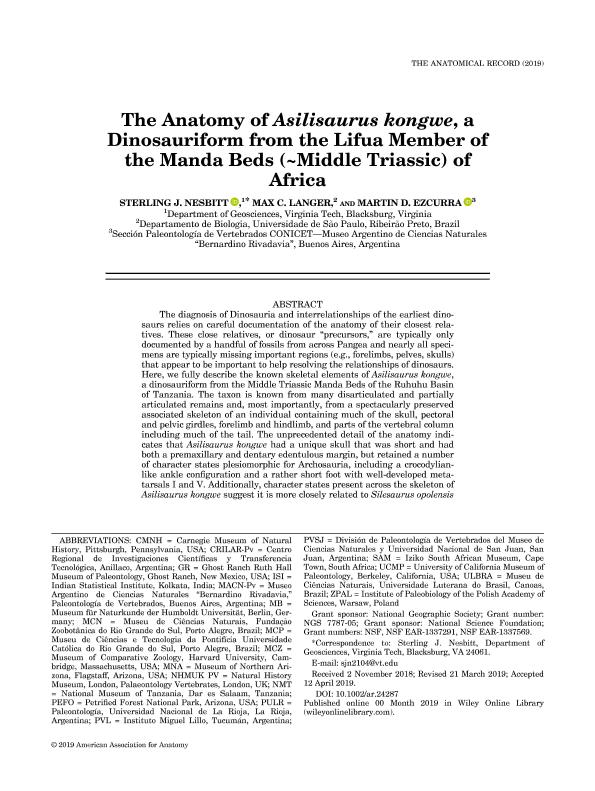Mostrar el registro sencillo del ítem
dc.contributor.author
Nesbitt, Sterling J.
dc.contributor.author
Langer, Max C.
dc.contributor.author
Ezcurra, Martin Daniel

dc.date.available
2021-07-06T11:53:34Z
dc.date.issued
2020-04
dc.identifier.citation
Nesbitt, Sterling J.; Langer, Max C.; Ezcurra, Martin Daniel; The Anatomy of Asilisaurus kongwe, a Dinosauriform from the Lifua Member of the Manda Beds (~Middle Triassic) of Africa; Wiley-liss, div John Wiley & Sons Inc.; Anatomical Record-Advances in Integrative Anatomy and Evolutionary Biology; 303; 4; 4-2020; 813-873
dc.identifier.issn
1932-8486
dc.identifier.uri
http://hdl.handle.net/11336/135536
dc.description.abstract
The diagnosis of Dinosauria and interrelationships of the earliest dinosaurs relies on careful documentation of the anatomy of their closest relatives. These close relatives, or dinosaur “precursors,” are typically only documented by a handful of fossils from across Pangea and nearly all specimens are typically missing important regions (e.g., forelimbs, pelves, skulls) that appear to be important to help resolving the relationships of dinosaurs. Here, we fully describe the known skeletal elements of Asilisaurus kongwe, a dinosauriform from the Middle Triassic Manda Beds of the Ruhuhu Basin of Tanzania. The taxon is known from many disarticulated and partially articulated remains and, most importantly, from a spectacularly preserved associated skeleton of an individual containing much of the skull, pectoral and pelvic girdles, forelimb and hindlimb, and parts of the vertebral column including much of the tail. The unprecedented detail of the anatomy indicates that Asilisaurus kongwe had a unique skull that was short and had both a premaxillary and dentary edentulous margin, but retained a number of character states plesiomorphic for Archosauria, including a crocodylian-like ankle configuration and a rather short foot with well-developed metatarsals I and V. Additionally, character states present across the skeleton of Asilisaurus kongwe suggest it is more closely related to Silesaurus opolensis than to dinosaurs; thus suggesting high homoplasy and parallel trends within Silesauridae and within lineages of early dinosaurs. The anatomy of Asilisaurus kongwe and detailed description of early members of clades found outside Dinosauria are clearly needed to untangle the seemingly complex character evolution of the skeleton within avemetatarsalians.
dc.format
application/pdf
dc.language.iso
eng
dc.publisher
Wiley-liss, div John Wiley & Sons Inc.

dc.rights
info:eu-repo/semantics/openAccess
dc.rights.uri
https://creativecommons.org/licenses/by-nc-sa/2.5/ar/
dc.subject
DINOSAUR “PRECURSOR”
dc.subject
DINOSAURIA
dc.subject
DINOSAUROMORPHA
dc.subject
EVOLUTION
dc.subject
MESOZOIC
dc.subject
TANZANIA
dc.subject.classification
Paleontología

dc.subject.classification
Ciencias de la Tierra y relacionadas con el Medio Ambiente

dc.subject.classification
CIENCIAS NATURALES Y EXACTAS

dc.title
The Anatomy of Asilisaurus kongwe, a Dinosauriform from the Lifua Member of the Manda Beds (~Middle Triassic) of Africa
dc.type
info:eu-repo/semantics/article
dc.type
info:ar-repo/semantics/artículo
dc.type
info:eu-repo/semantics/publishedVersion
dc.date.updated
2021-07-05T13:47:07Z
dc.journal.volume
303
dc.journal.number
4
dc.journal.pagination
813-873
dc.journal.pais
Estados Unidos

dc.description.fil
Fil: Nesbitt, Sterling J.. Virginia Polytechnic Institute; Estados Unidos
dc.description.fil
Fil: Langer, Max C.. Universidade de Sao Paulo; Brasil
dc.description.fil
Fil: Ezcurra, Martin Daniel. Consejo Nacional de Investigaciones Científicas y Técnicas. Oficina de Coordinación Administrativa Parque Centenario. Museo Argentino de Ciencias Naturales "Bernardino Rivadavia"; Argentina
dc.journal.title
Anatomical Record-Advances in Integrative Anatomy and Evolutionary Biology

dc.relation.alternativeid
info:eu-repo/semantics/altIdentifier/url/https://onlinelibrary.wiley.com/doi/abs/10.1002/ar.24287
dc.relation.alternativeid
info:eu-repo/semantics/altIdentifier/doi/http://dx.doi.org/10.1002/ar.24287
Archivos asociados
